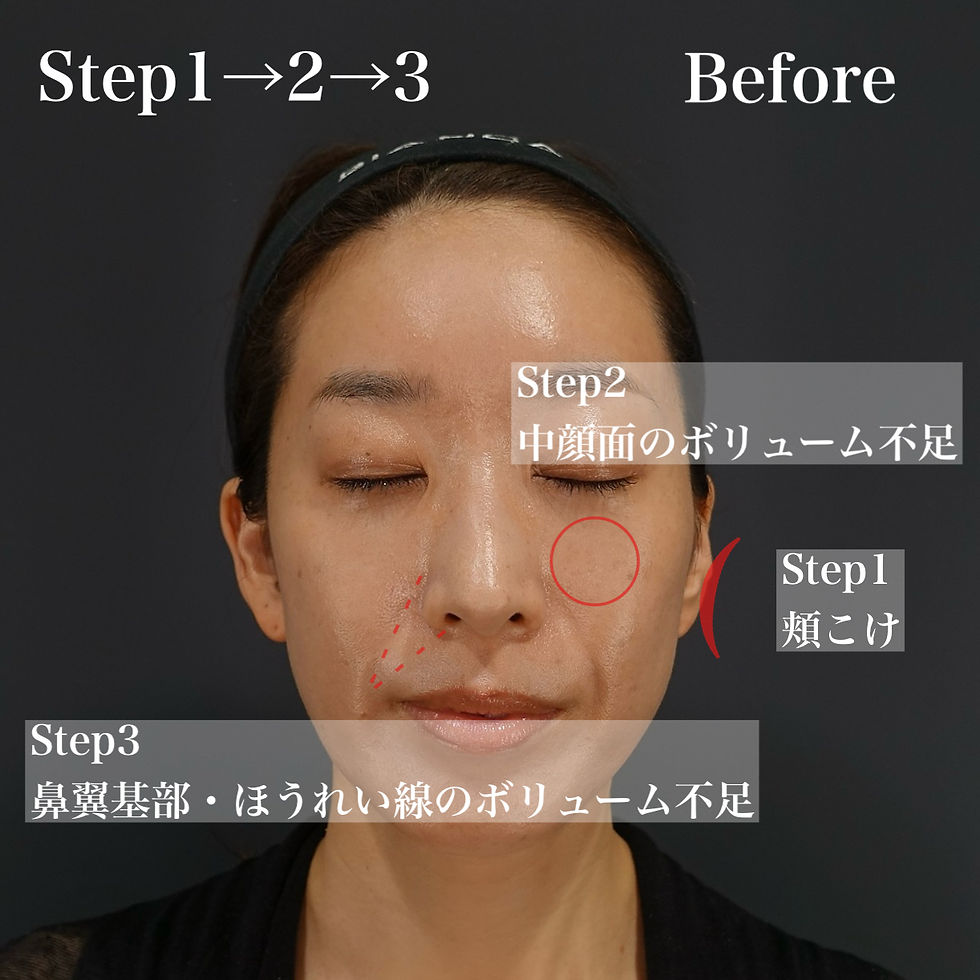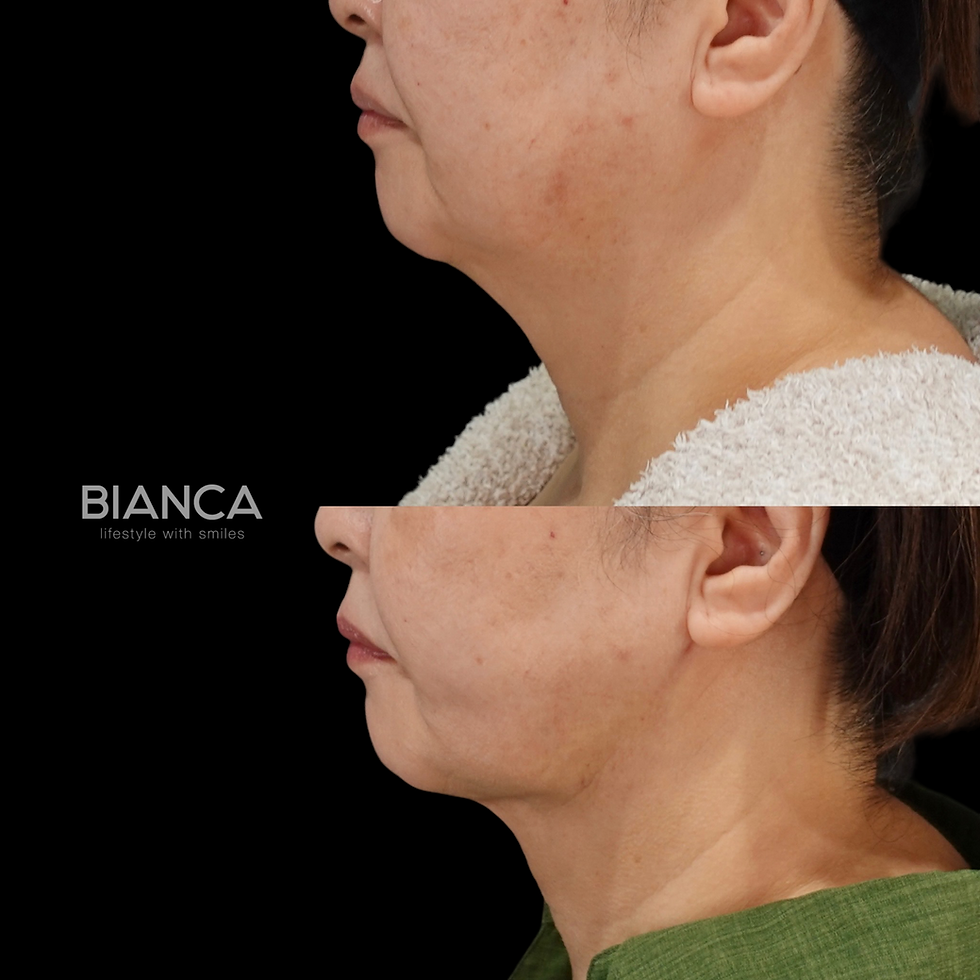
Anti-Aging Treatments
Maintaining balance of fluctuations
Anti-aging with cosmetic medicine
"Fluctuation" — changes in bones, muscles, skin, and fat
As we age, our facial structure gradually changes at an invisible level, causing fluctuations .
The main factors are changes in bones, muscles, skin and fat, and as these interact with each other, signs of cosmetic aging such as wrinkles, sagging skin and a loss of facial lines appear.
In response to these changes, cosmetic medicine can accurately identify targets and provide effective approaches.
Understanding the nature of aging
Approaching the cause of "fluctuations"
1
Bone
bone
As we age, the bones of the face become smaller and thinner. In particular, the bones around the eyes and cheekbones gradually become thinner, making the hollows around the eyes more noticeable and the cheeks appear sunken. In addition, the jaw bones that support the teeth also shrink, making the mouth appear to be pulled back and the lower half of the face shorter.
2
Muscle
muscle
As we age, our facial muscles gradually lose elasticity and begin to sag. In particular, the muscles around the eyes, cheeks, and mouth weaken, causing our eyes to open less easily, our nasolabial folds to deepen, and the corners of our mouths to droop. In addition, facial muscles that we use often tend to become stiff and tense, making it easier for wrinkles to form between the eyebrows and on the forehead.
3
Skin & Fat
Skin and fat
As we age, various changes occur in the skin and fat of our face. In the case of skin, components such as collagen, which maintains elasticity, and hyaluronic acid, which maintains moisture, decrease. This causes the skin to lose firmness and elasticity, making wrinkles and sagging more noticeable.
In addition, changes occur in the fat in the face, the plumpness of the cheeks seen in youth fades, and hollows under the eyes and in the cheeks become more noticeable. Furthermore, fat tends to accumulate unevenly in the lower half of the face, causing sagging of the face line.

Bone
Bone changes
[ Eye socket ]
- The bones surrounding the eyes gradually grow larger, making the eye sockets deeper.
- In particular, the bone under the lower eyelid (infraorbital rim) recedes, causing dark circles and sagging skin.
[Upper jawbone]
- The bones from the cheekbones to the upper jaw become thinner and shrink.
- The alveolar bone that supports the teeth is absorbed and the upper lip retracts inward.
-As a result, support for the mid-face is weakened, accelerating cheek sagging.
[ Lower jawbone ]
- The jaw bone becomes smaller overall, making the facial line unclear.
Loss of teeth leads to resorption of alveolar bone and a decrease in lower facial height.
- The angle of the jaw becomes wider, making sagging and swelling more noticeable.

Adds bone volume
ヒアルロン酸治療

Muscle
Muscle changes
[ Between the eyebrows, forehead ]
Among the facial muscles that are frequently used to express emotions, the corrugator supercilii between the eyebrows in particular is prone to forming vertical wrinkles (figure 11 wrinkles) due to sustained contraction caused by emotions such as anger or worry, and horizontal wrinkles are formed on the forehead due to repetitive movement of the frontalis muscle caused by expressions such as surprise, so these areas are prone to wrinkles forming earlier than other facial muscles.
[ Around the eyes ]
The orbicularis oculi muscle is frequently used in smiling and other facial expressions. Excessive contraction and repeated muscle movement can cause crow's feet-like wrinkles to form, especially at the corners of the eyes, and these wrinkles become deeper with age.
[Neck, face line]
Age-related muscle degeneration and hypertension in the platysma muscle that runs from the neck to the face can cause noticeable vertical bands on the front of the neck, which can also make the face line less distinct and accelerate sagging of the neck.


Skin & Fat
Skin and fat
[ Skin ]
Changes in skin firmness and elasticity The firmness and elasticity of our skin are maintained by two important components: collagen and elastin. As we age, the production of these components decreases, weakening the foundation of our skin. In addition, the amount of hyaluronic acid that keeps the skin hydrated also decreases, causing the skin to lose its plump appearance. These changes make wrinkles and sagging more noticeable.
[ Fat ]
Changes in fat distribution Fat that is evenly distributed across the face when we are younger changes as we age. A particularly noticeable change is the loss of fat that creates a plump impression in the cheeks, and fat tends to accumulate in the lower part of the face instead. Additionally, fat under the eyes moves forward, making it visible as dark circles and puffiness. These changes cause the inverted triangular contour that characterizes a youthful appearance to collapse.

Cutting-edge minimally invasive anti-aging treatment
Embrace RF Treatment
EmbraceRF is a groundbreaking treatment that addresses changes in skin and fat caused by aging.
It is one of the "Minimally Invasive Anti-Aging Treatments" and is a cutting-edge procedure that tightens the skin and remodels fat without surgery.

What is Embrace RF?
Embrace RF is a minimally invasive facelift that uses radiofrequency (RF) and combines two technologies, FaceTite and Morpheus8. It is an ideal option for those who are reluctant to undergo traditional facelift surgery or who want to regain their youthful appearance with as natural a result as possible, as it can achieve maximum rejuvenation with minimal intervention .
By restoring skin firmness and reducing sagging skin, while controlling fat as necessary, a more balanced lifting effect is achieved.
FaceTite
By inserting a very thin cannula under the skin and delivering RF energy from within, it tightens loose skin and controls fat, providing results similar to a facelift without the surgery.
×
Morpheus8
マイクロニードルRFを用いた皮膚のリジュビネーション(若返り)治療。真皮層や皮下脂肪層にRFエネルギーを送り込むことで、コラーゲン生成を促進し、肌のハリを回復させます。

Features and benefits of Embrace RF










